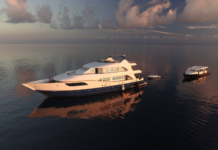The Besisahar portion of your Annapurna Circuit is the beginning of an iconic, delightful travel adventure in the country of Nepal. Not just a pit stop, Besisahar, after all, is a small town in Lamjung District that is the starting point of the fabled Annapurna Circuit Nepal — a trek that weaves through rhododendron forests, desert plateaus, medieval villages, and Himalayan mountain views. Credit it to respectful physical (and logistical) mindfulness on a chuckhole-restricted day to run a race.
This comprehensive guide will cover all you need to know to trek the Annapurna Circuit Tour from Besisahar, to ensure that you are fully prepared for your hike.
Getting to Besisahar
It can be reached by road from Kathmandu, Pokhara, a mid-Nepalese towns. If you fly in, it’s a 6-8 hour drive (depending on weather, road conditions) from Kathmandu to Mustang. From there, you can either catch the local bus, the tourist bus, or hire a car. This is a route which will also take you through some of the most scenic country in Nepal – stunning valleys, river gorges, and hillside farms should ensure the ride is more than a mere commute.
Besisahar is more reachable, and not so tremendously farther, just three to four hours by road from Pokhara. It’s great if you’ve relaxed/calmed down a little in Pokhara before stepping up onto your favorite walk in Nepal- the Annapurna National Park Circuit. Wherever you are coming from, toss in some fat early and do it from Besisahar.
Arriving and Staying in Besisahar
If you want to join the Annthe Apurna round trek, you must arrive in Besisahar one day before of trek. Even those small rest periods can be welcome opportunities to chill pill, reset, and get in Power Step mode. Very friendly little town, and a good range of simple (but comfortable) guest houses/tea houses/budget hotels. Most of these lodges have hot showers and serve Nepali food — perfect when you have some road wounds to lick.
“Shall we take a quick inventory of the gear here?” And if you realize that you accidentally left a key piece of travel gear at home — say, trekking poles, gloves, or a headlamp — you’ll be able to buy many of these accessories in Besisahar, where trekking shops cater to trekkers as well. So you will meet a few other fellow trekkers or local trail guides with some fine, experience-based advice on where and/or how to do switchback climbing up or down this range of potential weather conditions that will enhance your Annapurna Circuit Trek Itinerary.
Trekking Permits and Documentation
Before you go, make sure you’ve got the basics: you’ll require both an Annapurna Conservation Area Permit (ACAP) and a Trekkers’ Information Management System (TIMS) card. This paperwork is mandatory for all park entrants and is a way of registering and looking after the trekkers and the environment. If you didn’t already receive them in Kathmandu or Pokhara, you’ll also be able to get them at ACAP in Besisahar. If you have passport photos and your passport readily available, no.
Take your permits, and also hard copies of your ID, travel insurance, and emergency contacts. It is never known, with some luck may be these simple precautions can do wonders in front of road blocks and similar emergencies, or whatnot more, in case of trekking in the Annapurna Circuit.
Annapurna Circuit Packing List: Packing Must-Haves to get you started on Your Packing List
It is also the last chance for you to have that shiny gear or those supplies look even remotely close-do it like in one of Templed in the North’s outland villages, then, we might decide to like it. Smart Packing Packing needs to be lightweight, heavy with performance, and ready for alpine and sudden shifts in mountain weather. After all, you’re going to be crossing snow-bound, high mountain passes, so layering is all-important – thermals, fleeces, waterproofed and ventilated clothing are all essential items.
And, of course, you’ll be wearing those inside some hardy hiking boots, with a couple of pairs of trekking socks, a backpack,ck aa nd a water system — bottles, camelback, you name it. Here is a list of what you will need to schlep in addition to your items and any medicine you use. You will have a few places to restock at the beginning of the trail through a couple of townships. Gear up now, as you start northwards, straight up into the stomach muscles of the Himalayas via your Annapurna Round Trek.
Preparing to get Healthily Started
Besisahar is just 760 m above sea level, but you will be walking at 5,400 m (approx) at Thorong La Pass. It is another way of getting used to the altitude before you start the Annapurna Circuit Trek.
And don’t forget to eat, sleep, and drink. Use lots of space in your backpack with gear for your health, such as blister remedy and pain relief, and toss in the core first aid kit containing larger items such as headache and altitude sickness symptom treatment. Then you aren’t, and that’s a mistake because although you might be pretty much fine at Besisahar, this doesn’t mean you won’t be affected higher up the train. For that reason, you should familiarize yourself with the symptoms of Acute Mountain Sickness (AMS) so you can monitor other trekkers you’re with and beyond Besisahar. They need to be taking acclimatization days as we ascend to higher and higher altitudes — not only for safety reasons, but also because if you’re sick, you can’t work.
Planning Your Trek from Besisahar
You can decide whether to start your walk at Besisahar or hop a jeep somewhere on the journey to a town like Syange or Chame. It’s a much more natural immersion, and it’s a gentler way to acclimatize, trekking in from Besisahar. (And some simply eschew the lower reaches — especially in the summer, when the trail becomes a hell of dust and mud.)
Cultural Awareness and Environmental Responsibility
To the native people, and their environment, and to the kindest base from which to begin with the most courtesy, your trek. An ideal place to hop on is Besisahar. Its spiritual heart, a meeting place of different ethnicities that include Gurungs and Manangis. Take some time to pick up a few basic Nepali phrases, eat in local-run teahouses, and show an interest in village customs. Trekking is not onabout ly the mountains but the people who are this casual spread of confetti of communities.
You’ll want to make sure that you don’t litter our world well before you even begin your Annapurna Circuit. No to the single-use plastics, but yes, to the reusable water bottles with purification tablets, or a filter. Stick to signed paths of yore to avoid trampling sensitive vegetation and wildlife, and pack out all trash. Hence, responsible trekking is essential to conserve the beauty and will be able to save Mother Earth for future generations to come.
Conclusion
Preparation for your ride to Besisahar.. It is the first step to make the Annapurna Circuit Trek, not just another trip. From the mode of travel and permits to the wheat you throw in your pack and how you treat your head, every decision you make is contributing to the tone of the adventure of your life.




